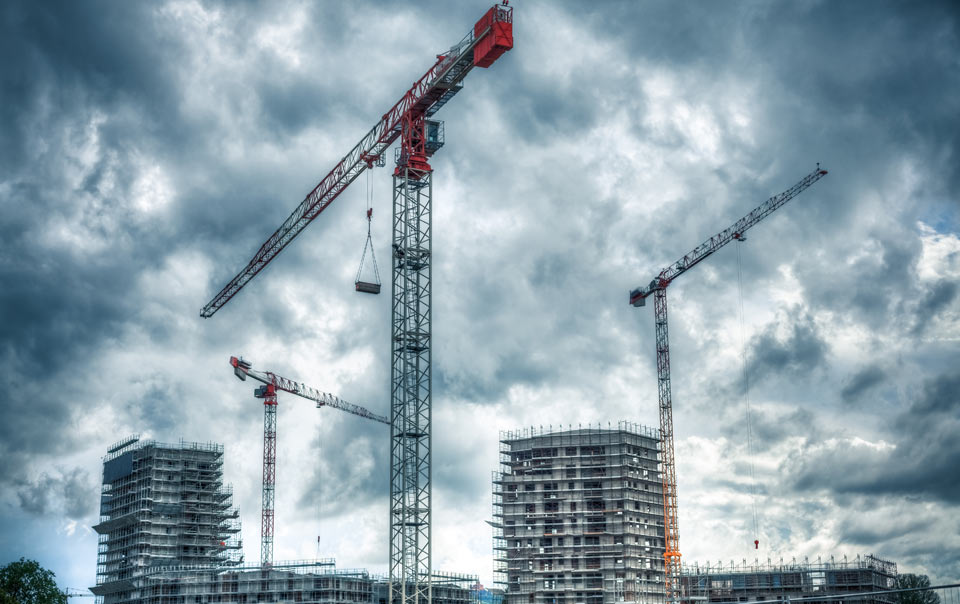Property damage from severe weather events can add both cost and time to a project. While it’s not possible to fully predict and react in a timely fashion to strong winds and storms, a documented and practiced contingency plan can help contractors prepare for the unexpected. Protect your site and project timeline by evaluating site-specific risks, properly securing materials and equipment and anticipating alternate construction plans.
Wind Hazards
Wind damage to structures under construction leads to millions of dollars in damages and delays every year. At construction sites, wind damage primarily involves masonry walls, framework, forms and roof coverings. Evaluate your site’s wind exposures to eliminate or significantly reduce the risk of damage or delay.
- Brace building components. Tilt-up panels, masonry walls and other building components should be braced and inspected according to engineering design or recommended manufacturer guidelines. Anchor roof panels on partially installed roofs, weld or secure decking each day, and consider covering large wall openings with tarp until windows, doors or glass curtain walls are installed.
- Properly store and handle materials for windy conditions. Loose materials such as sand, topsoil and mulch may need to be covered with a tarp or sprayed with water to prevent erosion. Erecting temporary windbreaks also can help keep the stockpile from being blown from the job site. It is also important to secure larger materials (e.g. metal sheeting or plywood), which could become projectiles and cause additional damage. Closely follow crane manufacturers’ guidelines for when operations should cease, and secure all other equipment from impending weather events.
Hurricanes
Hurricanes can be destructive, but they can also be anticipated, which allows time for planning and preparation. If your job site is located in an area subject to hurricanes, have it surveyed to determine the potential exposure to high winds and flooding. Create a hurricane contingency plan to help prevent loss to the job site due to winds, flooding, mud deposition and theft.
- Develop a preparedness checklist. Identify areas in need of protection, such as the field office trailer, equipment files, tools, heavy equipment, generators, compressors, welding machines, cranes, cranes on barges, tugs, work boats, fuel tanks, permanent materials and forms.
- Have a relocation plan. If the job involves work on or near bodies of water, make plans to relocate or protect all equipment and watercraft, including tugs and barges. Account for the amount of time it would take to complete any relocation.
- Secure the necessary supplies in advance. When a tropical storm has been identified by the National Weather Service, make sure tie-downs, banding material, blocking, anchors and other necessary protection supplies are available and organized.
- During a hurricane watch, prepare to take action. The project superintendent should review the preparedness checklist, formulate a plan to protect the job site, identify items to secure and consider moving material and equipment to higher, protected ground.
- In a hurricane warning, prepare for the potential for hurricane-force winds within 24 hours. The project superintendent may need to implement all protection measures.
- When landfall is predicted in the area of the job site within 24 hours, suspend all work activities. Complete the hurricane plan by assigning staff and timetables for completion and evacuate all personnel.
- After the storm has passed, assess damage, take steps to prevent theft and begin clean up. Hazards may include unstable structures, downed power lines that may still be energized, and wet or damaged electrical panels. Secure the site, including any equipment or materials being permanently installed, and assess and document damage. Notify appropriate utilities and contact your insurance carrier for damage assessment.
Heavy Rain and Water Damage
Water is one of the leading causes of damage to buildings under construction. Heavy rains can flood a site when drainage systems aren’t complete. These same rains can enter the exterior building envelope through unfinished window and door openings. If roof drains are obstructed, the rising water may find another drain path or try to settle across a level surface.
- Identify potential for flood and evaluate site drainage. Permanent and temporary drainage systems should be installed, maintained and inspected to ensure they are free of obstructions in the event of heavy rains or flooding. Delay installation of high-value subgrade equipment, such as electrical switchgear, until drainage systems are in place and operational.
- Avoid installing finished product, such as drywall, flooring, millwork, etc., until window and door openings are closed, roof is secured and the building is watertight. Use temporary coverings if necessary to protect finished work.
- The location and construction of temporary roofs should be part of the construction planning process or where installation of the permanent roof is delayed.
- Have a site-specific plan in place, including emergency response, clean-up kit and trained personnel, to assist with mitigating the damage.
Source: Travelers








